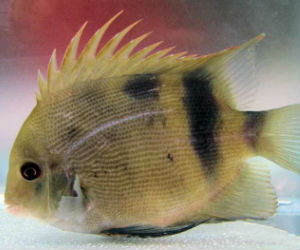
Uaru cichlids belong to a small genus consisting of two species, Uaru amphiacanthoides commonly called the Triangle cichlid or sometimes referred to as the poor man’s Discus and Uaru fernandezyepezi which is referred to as
Panada Uaru. There is another cichlid called the
Panada cichlid which belongs to the Apistorgramma genus that is sometimes confused with the Uaru.

These South Americans fish are easily identifiable by their unique compressed or pancake like body shapes which can reaches upwards of 12 inches in length. Their body shapes are reminiscent of Discus fish and
Severum cichlids. Uaru are large but shy fish and can hold their own in a community with fish of equal temperament.
The poor man’s Discus inhabitant’s rivers of the upper Orinoco, Rio Negro and Rio Branco of the Amazon basin of Brazil. They have been recorded as being found in the Rio Tocantins and Rio Xingu system as well in company with
wild Discus and
wild Angelfish. Essentially this species is similar in terms of aquarium chemistry as Discus fish are. The biggest challenge with keeping healthy Uaru is tank size and water quality.
Uaru cichlid species require a temperature range of 78-83 degrees in the aquarium with a pH of 5.5. to 7.0. According to some aquarists using Catappa leafs is helpful for keeping Uaru relative to reproducing water of the Amazon. It should also be stressed that water filtration is extremely important as this cichlid is prone to hole in the head disease.
Uaru tropical fish or Triangle cichlids are omnivorous fish, however, they have been known to consume live aquarium plants so be mindful that they may eat your favorite plants. Offering this species adequate vegetable matter is a must. They will do well with a varied diet of prepared cichlid foods like spirulina pellets, standard pellets and other items like freeze dried krill. Some aquarists use romaine lettuce and parboiled zucchini to mix up the die.
Both U. amphiacanthoides and
U. fernandezyepezi are offered for sale as wild imports and from the efforts of hobbyists who have spawned them. Uaru cichlid breeding has been successfully accomplished; check out the awesome videos below on both species. In traditional cichlid fashion it’s recommended to start about with four to six juveniles and raise them together in a large enough tank allowing a pair to naturally form. The tank should be populated with driftwood and rocks to form caves. Large clay flower pots are also helpful for hiding and spawning surfaces.
Uaru cichlid species videos
Other South America cichlids and related links


